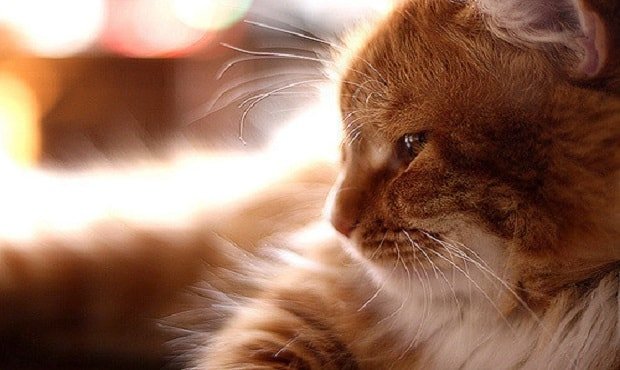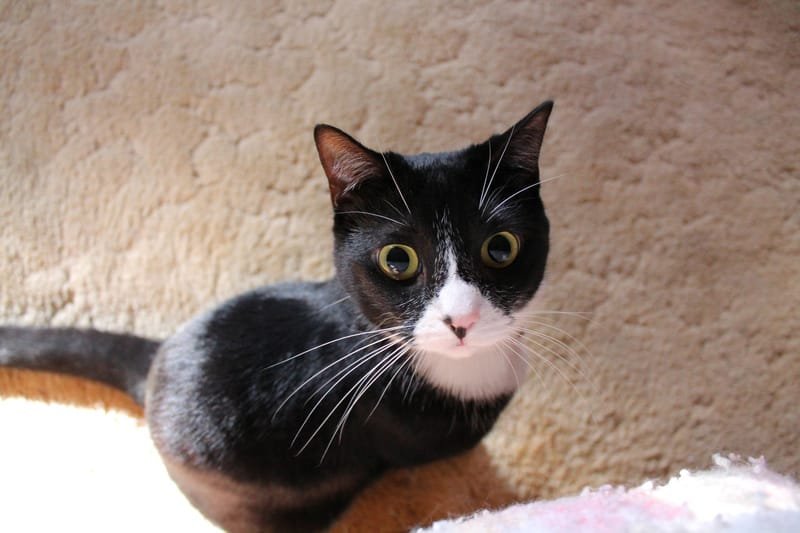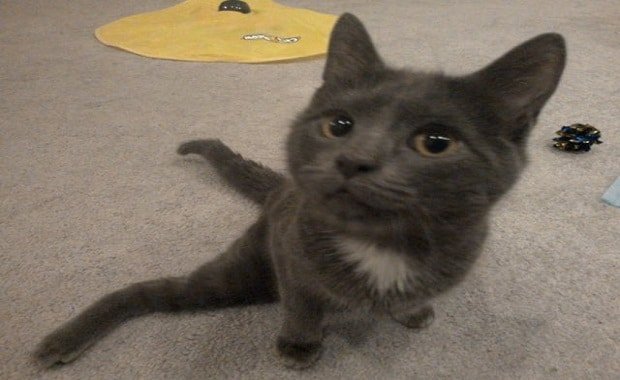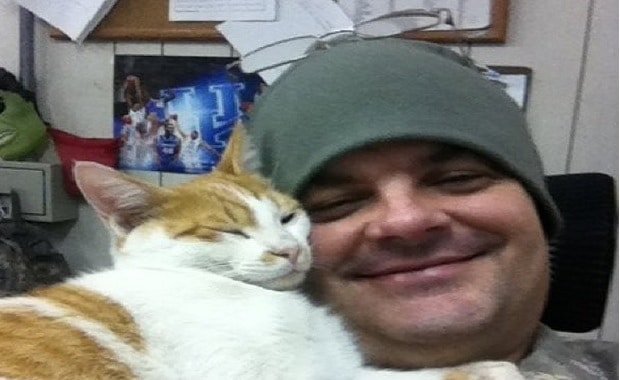All day, every day, our cats are doing cat stuff. They are notorious for knocking precious china off ledges, clawing at the couch, bathing themselves in their own saliva, eating, staring and, of course, sleeping. Cat lovers have spent years analyzing what our cat is trying to tell us: figuring out its meows, yelps, chirps, and trills; the unending mystery of a cat’s purr; or what its body language means.
None of this work solves the fundamental issue that cats are not able to talk. However, new research is pointing to the idea that cat communication is possible.
“I think the short answer is, it’s not as easy as learning to speak dog,” says John Bradshaw, author of Cat Sense and co-author of an upcoming book on feline training.
Cat communication with other cats is, aside from the mother-kitten relationship, almost entirely nonverbal, relying mainly on body language and odors. Human communication is largely based on verbal meaning, tone, and facial expression—which presents a problem as cats don’t have many facial muscles compared even with dogs, let alone humans. But Mikel Maria Delgado, who studies human-pet behavior and specifically cat behavior in addition to her work as one of the country’s foremost squirrel experts, thinks that cats are, in fact, trying to gather information from our giant rubber faces. She notes a few studies, including one from just last year, investigating whether cats can actually tell human emotion from a human’s facial expressions. The studies aren’t proof, but they do point us in the direction of comprehension.
“It showed that cats behave differently when their owner displays happy or angry emotional cues,” she says. (The owner part is important; cats don’t seem to care whether a stranger is feeling a strong emotion.)
The study indicates that extremes of behavior: angry or happy voice tones, comically exaggerated facial expressions, can indeed be read by cats.
“But this could just be a learned history, associating angry voice with bad things and happy voice with good things,” she says. For emotions like these, which amount to a cat learning to read human expressions, the cat is following a very basic associative pattern; basically, the cat only cares about your emotions insofar as those emotions have predictable effects on the cat. And most of these emotions would not be conscious. “When people are really tense, or hesitant or nervous, they’re giving off information, either via their body language, or their voice, or maybe even something like odor, like stress sweat,” says Delgado. “I think animals can probably pick up on those things and get information from that.”
This isn’t too different from the classic cat-comes-running-with-the-sound-of-an-electric-can-opener trick: all the cat’s doing is learning that that sound is sometimes followed by the giving of food. Does the cat understand that the opener is somehow involved in the food production? Probably not at all. However, that still gives us a tool to convey information to a cat: making an angry face or a happy face is a form of communication. So is yelling “GET THE HELL OFF THAT COUNTER!” The cat may not understand all the words, but it gets the message that it’s doing something that is upsetting its human.

Studies have investigated whether cats can tell human emotion from facial expressions. (Photo: E Nava/CC BY 2.0)
Aside from the portrayal of emotions, we get a little more nuanced in our communication with cats. Bradshaw says we can do this in one of two different ways: either by learning how a cat behaves and emulating it, or by training a cat in a similar way you’d train a dog.
The former option comes with some difficulties. One thing that doesn’t work meowing.
“I’m not suggesting people meow at their cats,” says Bradshaw. “Actually, people do meow at their cats, that’s quite harmless, but I don’t think it does much for the cat.” Meowing, being basically unheard of in feral cat colonies, is a trick cats have invented and use to get the attention of humans. They do it simply because we respond to it, not because they respond to it. Another issue: “The one we can’t do is raising our tails vertically, which is probably the most important signal a cat can give to another cat,” says Bradshaw. Yet again, our lack of tails screws us up.
However, there are a few options we can emulate. “There is a vocalization you can use, one I use with my cats, which is quite soft,” says Bradshaw. “It’s like a little bird noise, or chirrup: brrrrip!” (He’s rolling his tongue there.) That’s basically a greeting between cats, a nice, reassuring little signal that we’re all friends here. Bradshaw says his cats respond to that one very positively.
Another commonly prescribed act is the very slow blink, a trick favored by the TV host Jackson Galaxy. The idea behind it is that, unlike with humans, a direct gaze intimidates a cat so blinking helps diffuse the message. Both Bradshaw and Delgado are aware of this technique although they noted no studies which back it up. “I wouldn’t consider that too wacky of an idea,” says Delgado.
Similarly, there are certain ways to scare the hell out of a cat that would qualify as communication. Cats, remember, though they are predators, are mid-level predators: animals like coyotes, foxes, and even many birds of prey will hunt cats. So their instincts compel them both to murder small things and to be fearful of bigger things. “Looming over a cat, making ourselves bigger, that’s very threatening,” says Delgado.
But can communication be followed by real training?

Cat behavioralists say that slowly blinking at a cat communicates a lack of hostility. (Photo: Allison/CC BY-ND 2.0)
Absolutely, say both Delgado and Bradshaw, but not as easily as with dogs. Cats, despite their reputation, are indeed perfectly trainable. “It’s sadly easy to teach a cat to sit,” laughs Delgado. “When you pick things that they kind of do anyway, it only takes a few minutes.” You can train cats to respond to specific words (“sit,” “high five”) in pretty much the same way you’d teach a dog. The differences: Bradshaw says that food won’t necessarily be the best reward for a cat in training. Petting or time with a favorite toy might be a bit more effective. And cats, given their incredibly small attention span, aren’t very receptive to long, extensive teaching periods. “You have to figure out when the cat is receptive, because 90 percent of the time they won’t be,” says Bradshaw. Even during that 10 percent, it’s unlikely you would be able to command more than a few minutes of a cat’s attention.
Cats are able to make associations between words and actions just the same way dogs do, but Bradshaw says that they might actually respond to gestures better than they do to your words. It might be easier to train a cat to high five you by holding up your hand than by saying the words “high five.”
For both cats and dogs, both Delgado and Bradshaw believe that their name doesn’t mean anything like an identity to the animal. “I’ve never seen any evidence that cats understand their names, but you can use a name in the way humans understand them to mean ‘look at me’ to a cat,” says Bradshaw. Delgado thinks there’s an added complication because we so often refer to our cats by multiple variations on its name.
My own cat, Victoria, is usually referred to as Vix, or Vicky, or Cat, or Catso, or Kitsy. Hardly ever calling her Victoria. She certainly can’t piece together that all those different sounds are referring to her, even if she did understand the concept that beings could have individual names. Which she probably doesn’t. Thank goodness, then, the behaviorists say that there’s one surefire way to communicate with your cat.
It’s called “petting.”












